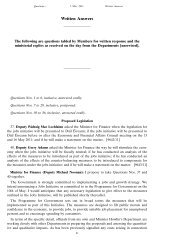Written Answers. - Parliamentary Debates - Houses of the Oireachtas
Written Answers. - Parliamentary Debates - Houses of the Oireachtas
Written Answers. - Parliamentary Debates - Houses of the Oireachtas
Create successful ePaper yourself
Turn your PDF publications into a flip-book with our unique Google optimized e-Paper software.
Questions— 14 February 2012. <strong>Written</strong> <strong>Answers</strong><br />
Under <strong>the</strong> Act, it is a function <strong>of</strong> a local authority to collect non-principal private residence<br />
charges and late payment fees due to it, and all charges and late payment fees imposed and<br />
payable to a local authority are under <strong>the</strong> care and management <strong>of</strong> <strong>the</strong> local authority concerned.<br />
In this regard, application <strong>of</strong> <strong>the</strong> legislation in particular circumstances is a matter for<br />
<strong>the</strong> relevant local authority. Interpretation <strong>of</strong> <strong>the</strong> legislation is a matter for legal advice in<br />
individual cases and ultimately a matter for <strong>the</strong> Courts.<br />
My Department is currently engaged with <strong>the</strong> City and County Managers’ Association in <strong>the</strong><br />
development <strong>of</strong> guidelines for local authorities in relation to <strong>the</strong> operation <strong>of</strong> <strong>the</strong> “care and<br />
management” provisions <strong>of</strong> <strong>the</strong> legislation. In particular, this guidance will deal with situations<br />
where significant arrears <strong>of</strong> non-principal private residence charges and late payment fees have<br />
arisen and where a person can demonstrate genuine hardship in having to discharge <strong>the</strong>ir<br />
liability in a single payment. In such cases, <strong>the</strong> guidelines will set out <strong>the</strong> modalities for local<br />
authorities, exercising <strong>the</strong>ir functions under <strong>the</strong> care and management provisions, including<br />
where payment <strong>of</strong> <strong>the</strong> outstanding liability in a single payment would result in hardship,<br />
entering into payment arrangements for <strong>the</strong> discharge <strong>of</strong> outstanding liabilities in instalments<br />
over a specified period.<br />
Waste Management<br />
419. Deputy John Deasy asked <strong>the</strong> Minister for <strong>the</strong> Environment, Community and Local<br />
Government <strong>the</strong> plans if any he has to bring in a deposit on all aluminium cans to discourage<br />
littering <strong>of</strong> <strong>the</strong>se items throughout <strong>the</strong> countryside; if he has any future plans to improve<br />
recycling systems in relation to our manufacturing and <strong>the</strong> end <strong>of</strong> life use <strong>of</strong> all non-biodegradable<br />
items; and if he will make a statement on <strong>the</strong> matter. [7621/12]<br />
Minister for <strong>the</strong> Environment, Community and Local Government (Deputy Phil Hogan):<br />
Directive 94/62/EC <strong>of</strong> <strong>the</strong> European Parliament and <strong>of</strong> <strong>the</strong> Council on packaging and packaging<br />
waste (<strong>the</strong> Packaging Directive) classifies items such as aluminium cans as packaging. The<br />
Packaging Directive is based on <strong>the</strong> concept <strong>of</strong> producer responsibility, which effectively<br />
requires producers to contribute to <strong>the</strong> waste management costs <strong>of</strong> products which <strong>the</strong>y have<br />
placed on <strong>the</strong> market. Under <strong>the</strong> Directive, Ireland’s requirement to achieve a 60% recovery<br />
rate for packaging waste in 2011 had already been exceeded by 2009, when a recovery rate <strong>of</strong><br />
70% was achieved. The material-specific recycling targets <strong>of</strong> 60% for glass and 50% for metals<br />
had also been achieved by 2009, with recycling rates <strong>of</strong> 76% and 50%, respectively, recorded.<br />
The Programme for Government contains a commitment to drive a waste reduction programme<br />
as part <strong>of</strong> <strong>the</strong> overall approach to sustainable waste management. A levy on packaging is one<br />
<strong>of</strong> <strong>the</strong> possible elements <strong>of</strong> this waste reduction strategy. A period <strong>of</strong> initial public consultation<br />
on a possible levy on packaging concluded in August 2011. The main issues examined in this<br />
consultation included:<br />
• The overall views <strong>of</strong> stakeholders on a packaging levy;<br />
• How a packaging levy might operate;<br />
• International experiences <strong>of</strong> similar levies; and<br />
• How a possible packaging levy might be structured to best contribute to a reduction<br />
in packaging waste.<br />
Following on from this consultation, I intend to commence a full review <strong>of</strong> <strong>the</strong> Producer<br />
Responsibility Initiative (PRI) model in Ireland in 2012, which will include a review <strong>of</strong> <strong>the</strong><br />
511


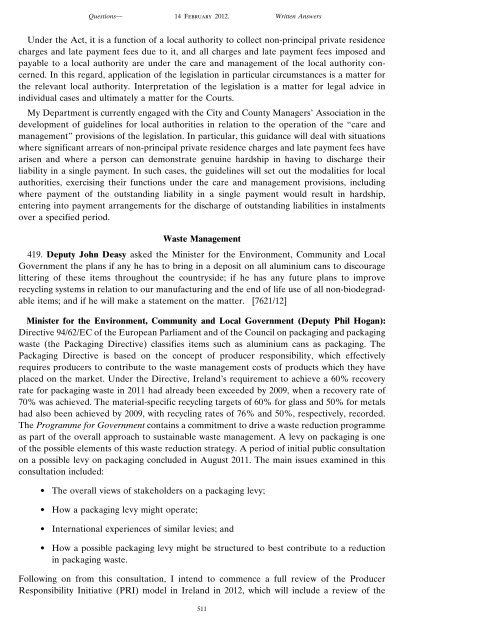

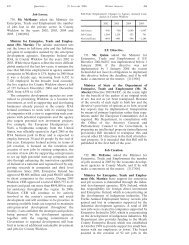

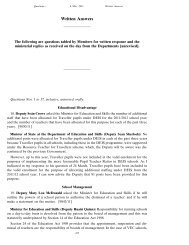

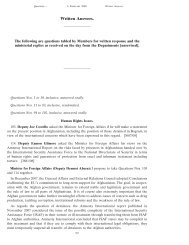


![[Deputy Michael Noonan.]](https://img.yumpu.com/30494839/1/190x245/deputy-michael-noonan.jpg?quality=85)
